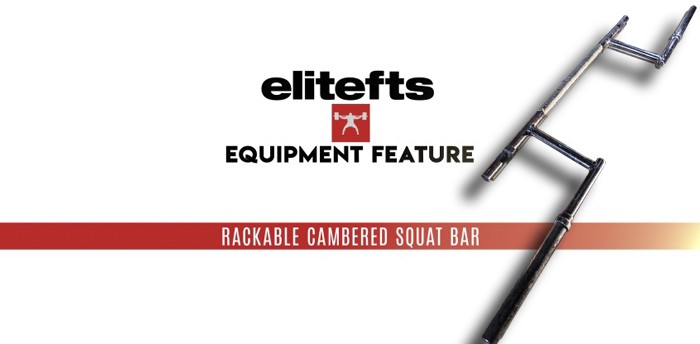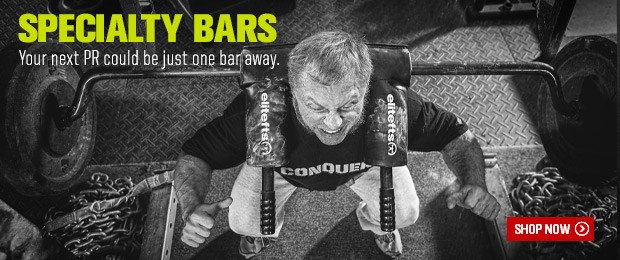
The Rackable Cambered Squat Bar is one of the most popular specialty bars elitefts carriers. The cambered design forces the lifter to be more stable, builds the posterior chain more than a standard bar, and can even be used to give aching shoulders a break from a regular squat position. The use of a cambered bar goes far beyond simply being a replacement for a standard barbell on squat day, though; it is a favorite among lifters and athletes of all kinds not only for its use in a competition-style squat but also for the large variety of special exercises you can perform with it. Many of the typical assistance and accessory exercise you'd perform for the squat or deadlift are improved with a cambered bar.
WATCH: Equipment Feature with Steve Diel — elitefts 3x3 Rack
In this Equipment Feature video, Nate Harvey walks through several exercises with Rackable Cambered Squat Bar, demonstrates the proper way to perform the movements, and then explains why and how you may wish to use them in your training.
Walking Lunge
The Rackable Cambered Squat Bar is great for single-leg variations in training. The instability caused by the camber of the bar helps strength the hips, lower back, and core. To perform this movement, take a big step out and drop straight down so your knee doesn't come in front of your ankle. As you drop down in the lunge, externally rotate your knee and keep the weight on your heel. Then try to produce as much force as possible, exploding out of the lunge as if you're jumping (don't actually jump). As you stand up out of the bottom of the lunge, pull back on the bar to keep your upper back tight and to help stabilize your hips and back.
Zercher Reverse Lunge
Holding the cambered bar in front of you in a Zercher position will increase the swing of the bar, forcing you to focus on stabilization and staying tight. To perform this movement, take a big step back and drop down into the lunge. Make sure that your front knee rotates out and your heel stays on the ground. Then stand up, producing as much force as you can, as demonstrated in the walking lunge. As the bar swings forward from the momentum you're forced to pull back harder, which trains your posterior chain more than a standard bar. Think about control during the eccentric portion of the movement and think about explosiveness during the concentric portion of the movement.
Cambered Bar Bench Press
Though it's called the Rackable Cambered Squat Bar, this bar is also useful for building the bench press. Benching with a cambered bar increases the range of motion on the press, further stimulating your pecs and shoulders without putting them in an unsafe position. This exercise is very useful for teaching the bench press to beginner or intermediate lifters, as it forces them to press in a straight path. If you press excessively back over your face, the swing from the camber will throw it into the rack. This is a common problem for many beginner lifters and pressing with the cambered bar instead can be useful in teaching proper bar path. The cambered bar is also very effective at bringing up arm strength, which is the limiting factor for many lifters who have disproportionally strong pecs and shoulders, and weak arms.
About the Product
Now you can do cambered bar squats and good mornings in any power rack. The cambered bar has a 14-inch camber so your hands can be positioned lower. This takes much of the upper back out of the motion and adds to the work being done by the lower back. This bar could very well be the answer you have been looking for.
Product Features:
- 14-inch camber
- Weighs 65 pounds
- Overall length: 91.5 inches
- Space between camber: 30.75 inches
- 11 inches of rackable space outside of camber on either side (total length of top portion is 56.25 inches)
- Fits in a standard power rack
- Great for building the squat, deadlift, lower back, and torso stability









